Sid Meier’s Civilization: Beyond Earth hit worldwide release on October 24, 2014. Developed by Firaxis Games and published by 2K Games, Beyond Earth takes Civilization back into space and tackles the challenges of colonising an alien world. This time around the game stays closer to its recent predecessor’s approach of doing things, and in many regards Beyond Earth will feel very familiar to the fans of Civilization V since the game uses the same engine and overall gameplay mechanics (1 unit per hex, Social Policies in the form of Virtues, and other mechanics).
Overall the game is enjoyable. However, with expectation set high because of the return to an alien world (Sid Meier’s Alpha Centauri remains a fan popular and classic to this day), and with the standards that the previous Civilization games have set, it is not hard not to feel a little disappointed with Beyond Earth. We need to remember that the release version of Civilization V was also a rough game at the start, and only after two expansions and years of community feedback it got to where it is today. The question remains, how well does the game hold up on its own?
Despite its shortcomings, and the overall lack of personality the game has with its factions, the game remains a solid and enjoyable experience. It offers a lot of new and interesting mechanics like unit evolution, a quest system, and the affinity system. The end-game mechanics could use some touching up however, but overall I’ve been enjoying my time with Beyond Earth. The game is far from being a masterpiece though and it definitely needs more polish as some elements don’t mesh perfectly. The game balance is also off in some areas, but it’s still a decent and fun game.
Check our previous write-up to know more about the basic concepts of the game as the review will focus more on how well these features were implemented and on things that were not explored in-depth in the previews.
Presentation
The overall visual quality hasn’t changed from Civilization V. The graphics do appear to be a little crisper this time, but it is hard to tell. Most of the differences comes from the alien setting and the new futuristic buildings and units. The presence of futuristic units and tile improvements does lead to some interesting visuals on the screen. Many of the end game units look good and have very distinct styles to them which bring the ideas of each affinity to life.
The game’s audio track is pretty good with memorable melodies, the problem is there doesn’t seem to be a large soundtrack, one thing that its predecessor had. For a game that you will play over 100+ hours with, the reduction of tracks is noticeable, more importantly the lack of faction specific tracks has a significant impact on immersion. This is probably one of the many reasons why the factions do not feel distinct and makes the game lack some personality of its own.
The UI is a sleek and minimalistic, using soft dark tones and white highlights to represent visuals. This leaves the game looking rather blend and sterile, and though it does have a sci-fi feel to it a bit more flair could have helped. The fonts can be small and the tone of the writing meshes too much with the background colour, making the text sometimes hard to read in the Civilopedia and sometimes even in the UI itself. Many times it will take time to find an old familiar feature, which can leave new players looking or wondering if an element does exist , like opening your list of old buildings and scraping them. It also took me a few moments to figure out how to change the focus of a city.
The problem lies in that the UI doesn’t explain itself. A good UI needs to be intuitive at a glance, and the tutorial doesn’t cover everything. This doesn’t mean the UI is a mess, quite the opposite, it is too sleek. Despite this, some menus look less organised or legible, like the diplomacy and military overview which feel cluttered. Overall, the new placement of many of the old options from previous games feels better but it does take a while to get used to if you are familiar with the older placements. The new UI is certainly efficient if not too efficient at times.
Game Setup and Options
Unlike previous Civilization games, your faction plays only a small role in your starting situation. In Beyond Earth, most of the faction’s customisation will come through play and each faction only has small bonuses that don’t stand out as much as one would usually expect. This sort of reactive growth is interesting but it feels that too much was sacrificed from the distinction of each faction.
Allowing each faction to be able to adopt different strategies efficiently doesn’t mean they can’t have a strategic bias or distinct elements that distinguish them from each other mechanically, and still be able to aim for any Victory Condition. For instance, the different factions don’t have unique buildings or units. Considering that the rest of the new game set up is selecting your load-out, makes one wonder even more why the faction’s unique trait couldn’t be more pronounced.
The rest of the Seeding Process is selecting your colonist (a basic bonus you get for each of your cities), and space ship and cargo (starter bonuses that help shape your beginning experience). This tailoring feature is interesting but unless you tweak your map setting, you don’t know what you are getting, so a lot of these choices are made partially blind. Albeit it makes sense you won’t know all the details. A nice touch, but the player will usually find the one or two options they really like and stick to those, although there are enough differences in factions to change what load-out you will use if you select another sponsor.
The player, as always, can select game pace, overall map size, difficulty level, and the overall planet type. Also, for those that want to tailor the game more there is an advanced option screen. Here you can select the number of opponents, pre-select them, define your planet even more (like in previous Civilization games), select the terrain type, enable or disable victory conditions, and several unique features like rampaging aliens and others we have become accustomed to in previous Civilization games.
What I found missing is the ability to have ocean-less (be it with lakes or no lakes) maps that loops East to West. This sort of map can only be achieved with the Skirmish map which is a fixed bordered box. An option to have skirmish like maps (which are very customisable) that loop from East to West would have been nice. So any dream of exploring a dry desert world with no water is dashed unless you are willing to do it on a skirmish map. Also, the Score Victory can’t be disabled.
Affinities
Affinity plays an important part in Beyond Earth, more so than your actual faction. Affinities represent your overall view on the future of humanity and they unlock specific buildings and units. So, having the tech will not be enough, as many techs will service more than one affinity. You will also receive additional minor bonuses as you level up within your affinity. This is actually one of the criteria of achieving an affinity victory.
Affinity will be earned by researching the corresponding techs and by completing quests. Affinity also plays a very important role in keeping your army modern as the upgrade phases occur based on affinity rank. Overall, each affinity favours different focuses in gameplay.
The different affinities are: Purity, Supremacy and Harmony. Purity will be good at having very effective farms and have better culture from tile improvements along with late game culture wonders; they will also gain some Health building benefits. Supremacy will have solid science and culture specialist buildings, and access to additional resources via satellites. Harmony will have the most spread-out bonuses and means to offset overcrowded penalties for individual cities with bonuses to health and growth.
It should be noted that although some hybridisation is possible, the player is strongly recommended to focus on one Affinity first and only have a few points in the others. Only in the late game there may be advantages of getting a few off ranks, but even then only a few is needed. This said, some affinity rank abilities are too hard to pass up. Supremacy level 3 is very useful for a faction that will build a lot of roads, while Purity level 1 is a must for anyone in the early game as it renders your explorers immune to alien attacks.
Overall, affinities are an interesting addition. They act a bit like Ideologies did in Civilization V: Brave New World, except they are even more pronounced on your faction than they were in BNW. They will influence the type of technologies and specialties the player will go for as well. The largest impact affinities will have is on your military, which will be covered in a later section.
Exploration and the Aliens
Exploration plays an important part in Beyond Earth, actually despite the sci-fi setting there is no ‘map reveal’ tech. To uncover the map one will need to reveal it manually. Though this can make exploring an alien world interesting it can feel a little out of place in the late game. Having the satellite coverage act as an unexplored tile reveal would have been a good middle ground, but alas only physically exploring the map is possible.
What does help is that the average scouting unit – the explorer – is a cheap unit and acts like an ‘archeologist’ of sorts (when compared to Civ V). Each explorer can only do one expedition dig, before the need to go back to a city to recharge (they are not consumed). However, a building quest, virtues, and an affinity rank give you extra expeditions that the explorer can use before needing to recharge at a city. These digs can uncover interesting things, including a shortcut to one of the victory conditions. Civ 5’s Goodie Huts are also back, in the form of resource pods.
The aliens are one of the defining features of the new planet. They tend to spawn from nests and these nests can be re-spawned if not capped by the player. Unlike its spiritual predecessor, the aliens are not a constant threat and can usually be dealt with by the mid game easily. This might disappoint those that want a more brutal planet that always fights back; this will be welcomed by those that actually prefer a planet that can be beaten to submission to make way for humanity (which one affinity is based off of actually).
Doesn’t matter which end of the spectrum you fall however, it seems the aliens are too easily dealt with. This is partially due to the fact that the hostility increase that was seen in the live streams pre-release doesn’t seem to happen now. Though aliens will get slightly more aggressive and start chasing down units, I never saw an alien attack a city even after I went Starship Trooper on them. Also, they seem to cluster amongst themselves making it a lengthy grinding experience to clear out a nest area in the late game as the individual units won’t be a threat but there will still be many to kill. This clustering also means they don’t cause havoc for the player if you happen to be far from them.
This is either a bug or that the initial alien aggression was toned down way too much by accident. This is a common thread in Beyond Earth, where there is some balance issues present in several locations. Also, there seems to be some issues on the method of ‘befriending’ the aliens which is normally achieved by letting a nest grow in your own borders. Normally this turns the aliens friendly and allows you to harvest the Xenomass resource naturally; however, the Xenomass is not always collected and the game does a poor job explaining the process to the player.
Cities and their Neighborhood
Nothing has changed from city management since Civilization V. To those that are new to the series: the system is a simple mechanic of building buildings or units within a city. Also, the population will either work on tiles on the map that will give yields or work in specialist’s slots within certain buildings that also give yields. It’s elegant and simple, factors terrain that is around of the city and not just the tile the city is built on.
Just as in Civilization V, the well being of your people is represented by a global stat, Health. Just like its previous incarnation this is reduced by the number of cities and the number of population that you have. This makes city spamming a quick way to lower your Health. Also, health buildings that offset this penalty are capped by the number of people in your city, making Health from Wonders and Virtues important to offset high unhealthy values.
This time the system is less punitive than Happiness was and the bonuses of positive Health are more permanent. This system is more rewarding and less penalising; however, it has the disadvantage that extreme values are not as worrisome or rewarding. Once above 20 Health the extra health feels like a waste of effort (unless you take certain virtues), and being below -20 Health results in not caring if you go down even further. Since the system is less punitive, playing at these low levels of Health is a viable tactic.
The largest change from previous Civilization games is that without Great People, special improvements are now tech based. Mid and late game techs will result in the ability to build high tech tile improvements that give special yields. Also, some techs will boost conventional improvements. Example: Going Purity will allow the player to turn farms into very useful tiles that offer both Energy (money) and even production. This gives a lot of tailoring to the player on how to shape city production.
There is an issue with automated workers though; sometimes the Route-to function will not work. Also, when Terrascapes are researched workers will lock into only building these. This can be seen within AI factions that will slowly carpet themselves with these expensive and long to build tile improvements. Also, an extra layer of management is in the use of satellites which the player can use to boost outputs of the city. This is sort of an interesting way to buff your cities, however most of these satellites tend to be in the less explored parts of the tech tree (to be discussed later).
The player can also build wonders; however many wonders will be mere ‘super buildings’ with slightly better stats than other buildings. Only a few, and oddly enough the ones that are earlier in the tech tree, will be interesting to build because they offer unique bonuses. This makes a lot of the end-game wonders disappointing mechanically and not just because of their weak presentation.
Trade and Espionage
Trade routes are per city this time, which considering how useful and even powerful they are will encourage the player to spam cities. Each city can wield up to 3 trade routes, and this will include puppet cities (cities that you conquer but don’t annex immediately) too. The reason trade routes are so useful is because external routes with other factions and stations (which are like independent mini-cities) can provide a strong science and energy boost (and a diplomatic bonus), while internal trade routes offer a food and production bonus to both cities. The only limit for internal routes is no mirrors.
Trade routes are useful as they offer strong bonuses and it is easy to power up your capital and still reap rewards for the donating city as well. Setting up trade route rotations internally can also increase output dramatically of all your cities as there will still be enough routes to gain the energy and science bonuses for external routes. The more cities you have the more internal loops and the more outward routes you can use. This is another element that causes the player to favour expansion over focusing on a few well built cities in Beyond Earth.
The player can also trade with stations which is one of their two purposes (the odd quest being the other). However, trading with stations is usually not worth it when compared to internal routes or external routes to other factions. There is a Virtue that does help, but unless that Virtue is taken, and the player can skip it even if they go deep down that tree, there is very little reason to trade with stations.
The other problem is that the player will need to manage a lot of trade routes by the end game as 3 per city can quickly build up. The game gives no means to auto repeat a past route, and it is sometimes difficult to see the previous route because of the game’s font. In addition, these lists can get huge as the AI also tends to play expansionist resulting in a really long list of cities to select a trade partner. Since the system is straight from Civilization V, it is hard to imagine why the management system has not been improved.
As for Espionage, it’s an interesting system as the player can gain science and energy from a target, and even steal tech. At higher levels players can also gain free troops, disable satellite networks, and even take a city peacefully. Science, tech, and defectors’ covert actions are extremely useful as it can be an alternative method of gaining these resources. Defending is easy enough with the aid of mid game buildings and even a late game satellite which will block the worst elements easily.
The two problems that arise however is that the affinity based spy actions are at the same rank as flipping a city, making them less than interesting to use as an extra city is usually a more appealing prospect as the player can also flip the enemies’ capitals. Also, with the way how intrigue and the spy network establishment work, it is easy to exploit the system to raise your intrigue very fast. There are strategies out there on how to win Domination within the first 200 turns by flipping all the capitals quickly. The system would be great if it were better balanced.
Technology
The Technology web is another difference in this title. This time, techs are broken into branches, which act as advancement points on the web, and leaf techs, which are sub techs that take longer to research than an equal tiered branch tech, but less time than a branch tech of the next tier. Also, pre-requisites are not a case of having all previous connecting techs, having any one of the previous tech along the line will allow the player to move on forward. This encourages players to sometimes skip entire branches of the tech tree.
Skipping leaf techs are expected as many are situational and tied to an affinity. It’s more efficient to focus on a primary affinity first so the player will quickly start skipping the leaf techs of other affinities. The goal was to have the player only research a select number of leaf techs and even skip a few branches at times. In this the game succeeded, though many circumstances will make the player regularly skip the same branches.
The downside of all this though is that many of the more interesting satellites are in these less then often explored tech paths. This under serves one of the new elements added to the game. The player will forget they have access to such devices because they either show up too late that you are used to playing without them, or you did not get a chance to even research them in the first place. It doesn’t help that the orbital attack satellites are both end tier techs, both the weaker and stronger one, and the stronger one is on a branch that connects to a tech needed for one of the victory conditions.
Overall, the tech web is a good idea and does give the player a lot of choice and exploration of the technology system. However, the placement of some of the satellites needs to be reconsidered to encourage their use in the game. Also, it is sometimes hard to tell wonders from buildings in the tech web, due to its monochromatic presentation and that they are written in the same format so that even the mouse-over tool-tip doesn’t help differentiate them.
Virtues
Civ 5’s Social Policies have been replaced by Virtues and they operate exactly the same way with one key difference. Each tree tends to go 15 policies deep but there are only 4 trees. In addition, spreading out is also rewarded along with going deep. These synergy bonuses and specialisation bonuses will give the player a lot to think about and give many tough decisions as many virtues are also useful in only certain points of the game. It also follows the same rules the tech tree does; you only need one of the previous connecting lines to go down in the tree. Overall, the system is interesting.
The only real criticism is that there may be balance issues. At the moment, only the Prosperity Tree seems to be effective at getting rid of unhealthy. Within 3-4 policies of each other you can go from -30 Health to +30 Health, but this requires going deep into the tree. This doesn’t mean the other trees are useless; actually they tend to be all very useful. It is just that Prosperity is also the growth tree, so there doesn’t seem to be many alternatives to having high health even if you focus on building up as opposed to expanding.
Quests
The quest system is the way Beyond Earth tries to convey a sense of lore and story to the player. The system acts as a way to help the player steer through the tech tree and aid in shaping the affinity preference of their faction. Actually, in the early game, quests will be the largest source of affinity points. Also, in the mid to late game the player will receive affinity specific quests. These quests help define the setting and the path the player chooses, though the simple presentation might cause many to just read the bonuses and skip the lore.
Occasionally the player will also receive quests from stations. They will sometimes give quests that will require you to attack another station or establish a trade route with them. Some affinity quests will also involve stations as well. Some of these can be skipped as the player might not be interested in destroying a station as it can cause severe diplomatic repercussions. These can become annoying when a primary affinity quest does entail a station’s destruction.
There is another type of quests that the player will receive and these are the quests to customise additional bonuses for your buildings. When you complete a building you will receive a quest with a short narrative where you pick one of two possible bonuses. This gives a lot of discovery for a first play through; though they can get a little repetitive they still remain an interesting source of customisation. Also, the lore for some of them is interesting.
The one problem with these quests is many of the choices are no-brainers or very situational to take the other. For example, +1 Trade Route per city with an Auto Plant or having your Trade Routes immune to alien attack by having a Perimeter Fence are obvious choices. Most are simple choices giving a bonus here or there; they seem minor but can add up. The system does give that extra layer of customisation and a bit more lore for your faction.
Diplomacy
The Diplomacy system seems like a trimmed down import of an earlier version of Civilization V’s diplomacy system. This makes diplomacy one of the weaker elements in Beyond Earth. The leaders use repetitive one-liners, and the text is generic between leaders and the only variation is in affinity based banter and introductions. Also, the exploit that you can offer EPT (energy per turn) for a lump some of energy, then declare war on your target to cancel the EPT term is back from the release version of Civilization V (which was corrected with expansions).
There is no way to see the deals and relations between leaders except for cooperative agreements. There is no way to see which station each leader is dealing with, which makes it easy to generate an unforeseen diplomatic incident when you decide to attack a station. Though the player will receive notifications for wars, there is no way to verify these quickly, while information like relations to stations will always be hidden.
Considering that the AI is very sensitive with attacks against stations (I have seen these acts trigger as much hostility as wiping out a Cooperative Partner of the same Affinity), it feels having this knowledge hidden is inappropriate. Also, the information that is present seems cluttered and not neatly presented. Though it is possible to maintain friendly relations with opposing affinities, the AI is very sensitive to transgressions and not knowing all the ties can cause what appears to the player as erratic behaviour.
It doesn’t help that the AI can make requests the player can’t, like stopping attacks on stations. So, unlike the AI that will go full insane on you for the same act, you can’t even ask an ally to knock it off. Also, the taunts from hostile factions have returned; even if there is nothing to be taunted about, a generic “we hate your affinity”, and when that is not available a taunt about just being silly will be issued. These tend to come often even from just one opponent. This was one element that should have not been lifted from Civilization V.
The game introduces the ability to give science to an ally. This literally is giving science, effectively slowing down your own progress. Since all victory conditions are so dependent on this, it feels like a trade offer no sane player will ever agree to and can be devastating as an extortion of a defeated war victim.
The player can also accumulate favours but the system is not as interesting as it sounds. Favours seem to be given not as a fair trade but as a token for accepting a request for aid. They can be used to get something back later but it seems the trade-back value will always be lower than what was given for it. Also it is dependent on your relation status, so if you have become hostile all the favours will depreciate from being worthless to useless. Sometimes it seems favours can be used to ask an opponent to stop spying on you and the like, but the window it can be used for this is tricky and it won’t be uncommon that the player will miss the window. There also seems an opportunity lost that favours can’t be used to forgive the indiscretions of the player.
Favours are not completely useless, but it will take a large number of them to get anything of value out of an AI. However, because of favours, the AI doesn’t seem to offer fair trade offers anymore and only makes requests for aid for favours (which are rarely traded back for the same value even at high relations). Sometimes it is better to just counter-proposal a fair trade unless the goal was to gain the diplomatic bonus ‘accepted a request for aid’. The system can be interesting but definitely needs more work to be considered a worthwhile feature.
Units and Warfare
The biggest change in Beyond Earth is the unit upgrade system. The player doesn’t need to worry about unit upgrading as all units will receive the evolution after it has been selected. Also, the unit upgrade occurs based on affinity, which means any tech will increase the player’s military capability as the military tech level will be a natural representation of the overall tech advantage. However, since affinity is also gained from quests this transformation can come quickly and early for the player if they focus down one path.
This doesn’t mean that military techs are not needed, since these tend to unlock special units especially those that are exclusive for an affinity, but one will need to meet the affinity requirement to be able to build them. These units are extremely powerful and can tip the scales of battle. A single CNDR unit can tip the scale of battle in the early game for a Supremacy player, while Power Suits can be a reliable backbone of a conquering Purity player. The Harmony player will enjoy rapid moving lone wolf units that thrive in miasma.
The evolution of units is interesting as it makes the player make choices on what sort of military to field. Will it be defensive, offensive or balanced? Will it specialise in taking down cities or military units? Will most of your Harmony units be better in miasma or be lone wolves? How adjacency dependent will your Supremacy troops be? Will range be favoured over speed for your artillery units? These are all interesting choices that will shape your battle strategies.
The game does have a lack of air and naval units though. It has only one air unit and only two naval units: the carrier and a ranged gunboat. The ability that some vehicles will hover in the late game offsets this a little for naval warfare. However, it would have been nice to have melee naval units and at least one more air unit. Fortunately the roster of land units is healthier; though the player will still feel the game lacks units. Some of it is a perception issue since a Ranger and Gunner will feel like the same unit. It actually is no different than researching a crossbowman to replace archers in Civ5. This said, the player will still feel a genuine lack of diversity in some areas (naval, air, and no anti-armor or anti-air).
One thing to note is that cities are far more fragile this time. Cities that do not have defense structures can be easily one-shot by siege specialised end game units. Even regular units can make quick work of a fully defense structure deprived city. This balance may be frustrating for some that have come to rely on a city’s natural resilience from Civilization V, but it should be noted that this new balance might have merit. It focuses the player to actually build defensive structures to protect cities or have armies fight the enemy on the field.
Your city is not your first line of defense anymore; it is your last as it should be. A fully warded city with a ranged unit can hold its own decently well even against siege masters, and can be difficult to take with no specialised units. This however does mean the early game can be very fragile as some of the best city defenses come in a little later or the player did not have time to build them yet. The difference between a warded city and one that is without protection is day and night. Overall, it gives importance and value for such buildings now.
Military AI
The failing in the military AI is that it can’t use terrain to maximum effect and can’t multi-task. When presented into a multi-front war it will focus on one flank to get decimated in the other. It is not hard to trick the AI into this even in a single front war by using smaller attack forces from different angles, or waiting till the AI attacks and while defending launching a simultaneous assault on its own lands.
This can also be a serious issue when the AI happens to lag behind affinities, which happens too often at the mid-range difficulty settings and lower. Since military units upgrade based on affinity it is not hard for the player to exploit this gap and curb-stomp the AI with far superior units. The reverse is also true, but only at the higher difficulties will it have a chance to do this and it won’t exploit it as often.
Also, while at war the AI has trouble expanding which means a long 100 year war will slow down the AI’s growth which the player can exploit by still growing themselves. This doesn’t mean it won’t expand but it will only if it has a completely safe direction to expand into and has enough cities away from the front. If the player can press each city or the AI is boxed in (this includes the presence of miasma and alien nests), then the player can contain an AI by just staying at war.
The positive side of the military AI is that it doesn’t place its artillery units in front of its melee units, though a clever player can easily trick the AI in thinking the wrong side is the front it does help that the AI won’t do this by default anymore. Also the AI will use satellites to great effect, dropping down a line of Tactical Satellites on a war front. Sadly, these show up in the mid to late game only and won’t be seen often. Overall, a tactically competent player will be able to win most wars even if outnumbered or militaristically behind.
Overall AI
The AI overall seems to be a little on the weak side, it has trouble competing with an effective player. The normal mode is easy, and the hardest is probably comparable to hard or very hard (a little under Emperor in Civ V). So nothing comes close to an insane or impossible difficulty setting. The main difference between the higher difficulties and lower ones is the bonuses the player and the AI receive, with the higher difficulty giving the AI faction health, economy and science bonuses, and unit health bonuses.
The game will not challenge a player who tends to play these games at the highest difficulties. However, it will offer proper resistance for a more relaxed player. The AI is able to race to one of the none-combat victory conditions as well. The AI does have trouble invading fortified islands and secured continents, or pulling off the Purity victory condition quickly. A skilled player will be able to handle the AI easily in most cases.
One chief problem, as mentioned earlier, is that the AI seems to lag behind in affinity growth, because a lot of buildings require higher affinities to be unlocked it causes the AI to be stunted a little economically. This is in addition to the vulnerabilities it causes militaristically for the AI. Only at the highest difficulties will the AI be able to keep up or even surpass an effective player in affinity ranks, but only by a little, usually. The most skilled players will stay ahead of the AI, as some strategies are just too ‘useful’ and some exploits can be used to push you ahead of the AI easily.
Also, the AI seems to have trouble dealing with aliens, and expanding into alien infested zones. This causes the AI to be only competitive if it has a safe expansion window free of aliens (or was cleared by a rampaging player) to expand into. This causes the AI to get boxed in too many times; you will always see a few on a large map and will always see it happen on smaller maps. This makes it easy to defeat the AI on duel sized continental maps at any difficulty level as the AI will need some breathing room to be an effective opponent.
The Tedious Road to Victory
The victory conditions are conceptually interesting but tend to suffer several flaws which do impede the end game. Overall, the game offers 5 victory conditions; however, in a normal play through you will only have access to 3. This is because 3 victory conditions are based on affinities. Since, you will be racing the AI for winning the game, trying to top off more than one affinity will not be viable (usually). The goal was to make the end game process more involved but in some ways it does the exact opposite as it feels drawn out and sometimes requires tedious micromanagement to complete. The only condition that is simple is Domination, which requires one to be the last to still hold their own capital.
The Contact victory is the mirror of a science victory in Civ5. Though it does require you to go down branches that you don’t normally do for affinity based techs, it can be snuck into it quickly. You can trigger the victory process pretty early compared to the other victory conditions by using free tech opportunities to speed down the path. Also, since you can get lucky and find a code fragment during an archeological survey, you can begin decoding the signal and building the beacon in the mid-game before anyone else has even gotten close to theirs, while still researching other techs and building up your faction.
Some of the affinity based victories suffer from a very basic flaw that is they are needlessly micro intensive. Though Supremacy is manageable and has the interesting side-effect that to achieve it you must sacrifice troops, the same troops you’d use if someone was to go to war to stop you, Purity can be a nightmare. Unless the player knows beforehand, not building a mag-rail network before you begin the process makes the micromanagement even more painful. It requires summoning in manually, each turn, and one at a time for a total of 20 colonists, which you must settle using city spacing limits. This will require about 4 separate spots. This can be needlessly challenging if the game is played on an island map.
It should be noted that these affinity victory conditions are pretty much another type of race to the finish line victory condition. Requiring getting a few specific end-game techs combined with enough leaf techs and completed quests to hit rank 13 in your primary affinity. Once that is done, you can initiate the victory process. There is very little another faction can do to stop you unless they race faster to their own, or attack you and destroy your wonder while protecting theirs. Though the project is vulnerable to attack, it still remains a race style victory as opposed to a tug-of-war mechanic like the Diplomatic or the Cultural Victory was from Civilization V: Brave New World.
Also, the way the end game is designed, the player, or AI, will rush to a victory condition which will trigger the final stretch of the game before any other end game tech is researched. Thirty to forty or so turns (build time plus activation) is usually not enough to experience the plethora of end game techs as you will only have time to research only a few of them. Furthermore, the player will probably be focusing more on military production and actions to prevent the AI from winning while they complete their own victory terms.
Lastly, the Victory Screen is just that, a screen. There are no Demographics comparing your standing with other factions, and no graphs and map replay. Though the graphs can be found in the “Other” menu on the title screen, this will only offer the player the basic graphs. It feels bizarre such comparatives are missing on the Victory Screen, and even the replay doesn’t have the level of detail most players are used to. Also, there is no way to disable the Score Victory.
Quest Bugs and Stability
Overall the game runs smoothly. This said, there have been reports of players having trouble to run their games. I have not seen any of these issues personally, nor as anyone I know who played the game experienced them either, so I have no first hand or second hand knowledge on these issues. There have also been reports of issues in multiplayer (crashes and glitches if loading a game). The only technical issues I got was the game’s process won’t completely shut down when exited, which requires the user to manually end the process in the task manager; this happens often but usually ends on its own after a few moments.
There are a few minor bugs and graphical glitches, along with several quest problems. The most common one is how a unit remains in the upgrade screen when you are viewing another unit. This doesn’t break anything, but is odd to see and happens quite often.
There are quite a few quests that do not update the location or even update the next step. You will experience an average of one or two such quests per game, such quests can’t be completed and since these tend to give the player Affinity Points, it can be frustrating. Another quest glitch is when a quest asks the player to build a building in a city that can never build such a building, causing the quest to be stuck.
Replayability
This is a mixed affair, though mostly positive. The game definitely has the one more turn phenomenon; however, due to certain weaknesses in the end-game, bland factions, and the AI’s overall weaknesses the game is not as tempting as its predecessor. The early game is definitely fun but can get drawn out for too long for a bad start, while the mid-game is certainly interesting. These two elements combined is usually enough to try a new game on a different map or attempt a different play style. The end game can have interesting warfare as many of the units have reached their full maturity and you have access to your faction’s special units.
This said, the AI still has trouble dealing with a well prepared player making some of the late game battles lop-sided. Also, the victory conditions can cut the end game short despite their tedious nature, the player will not fully experience many of the late game techs. In addition, as mentioned earlier, some of the end game mechanics can be a little boring and tedious (victory condition management and trade route management) which makes them something the player isn’t too eager to initiate.
This sort of weaker end game makes the prospect of replaying the game not as enticing as it could be. Most of the interest will be for the early and mid-game, and the chance to use some of the late game units for those that like warfare. Also, players that are used to playing at the highest difficulty will find the game too easy which can also hurt replayability considerably.
The current bugs, balance considerations, and quest issues can be frustrating. But, overall the game is addictive, though the lack of immersion does hurt it.
A Long Word on Immersion
Civilization: Beyond Earth lacks personality, especially involving the other leaders. Though difficult to put into words, after much thought I believe I can phrase why. Without history as a reference it leaves the game entirely on its own to weave the immersion of the world to the player. Furthermore, Beyond Earth focuses on a more open-ended narrative (being closer to Historical Civ than to SMAC) which means the little things will be even more important in weaving this sense of wonder. It is within these little things that Beyond Earth did miss its mark.
Even within an open-ended narrative the characters can be given very distinct personalities and have their persona shown to the player. Though the affinity growth is shown on the characters, their dialogue tends to be generic except for the few spoken dialogue, the written diplomatic dialogue is mostly the same between leaders. This is compounded that many times there will not even be a spoken one-liner. Though each faction AI does seem to have different play-style personality, they do not shine through nor are they obvious as global circumstances might force the AI to play differently.
The atmosphere could have been better; the lack of unique musical themes for each faction is subtle but noticeable. Without any unique themes or any theme playing during diplomacy doesn’t help the game set personalities for each leader (this was one of the subtle ways Civ V achieved personality with the separate leaders). Considering factions have no unique units and buildings on their own, the lack of music compounds the effect that each faction feels the same. Most of the differences develop during the game via virtues and affinities; however, most of these will not be obvious from the player’s perception when dealing with the AI factions.
This goes with the game’s lore as well, though the in-game database is expansive and can be quickly accessed from the tech screen or other screens with a right click, it can’t be accessed from their own pop-up screen. Requiring the player to go into menus to look up the lore of what they just discovered or built. It becomes all too easy to not dig these things up and merely play with what bonuses you receive for unlocking techs; often times not knowing or understanding what the quote was trying to reference.
Wonders use ‘blueprint outlines’ like art as visuals, which on its own wouldn’t be bad but it doesn’t help create immersion either. Also, the wonder quotes tend to not illustrate or describe the wonder you just built, seeming to be more random without context to connect them with. This leaves the player detached from his achievement. This is quite a shame as a lot of the other written material is quite interesting.
Also, all the quotes in the game are read by the narrator even those that are written by the faction leaders. I did enjoy some of the quotes and made me curious to read on more. You don’t feel any differentiation between ‘random excerpts’ and those written by the sponsors, making each quote feel like a historical excerpt only. The lack of making each leader more pronounced combined with the easily skip-able tech lore makes it easy to not feel as immersed when playing the game.
The only real distinguishing differences between the factions as they grow in the game are from affinities chosen and the extensive virtue system, which are done very well, fortunately. This leads to powerful customisation of your faction but little difference in making them feel separate at the start, and even in the late game the only apparent difference will be the affinity as the other layers of customisation will not be immediately apparent.
However, this doesn’t mean the game is without atmosphere. The evolving units, visual style of the environment and the aliens, the central sound track, the visual style of each affinity, and the quest system help weave you into the game. The texts of many of the quests are interesting combined with the pick-your-own adventure choice-trees of follow-up quests is definitely nice. Even the texts of the building upgrade ‘quests’ are interesting to read. Though a little more visual flair for the more important quests would be nice, it does get you engaged into the game.
The quotes for the techs and the affinity are quite interesting sometimes, though many of these quotes will be more like short “quotable” one-liners than something long and thought provoking. This written material in the database is quite interesting and seems to be written from the perspective of even further in the future looking back. However, none of this helps differentiate the leaders from each other during play and most of the interesting lore is hidden from the player’s immediate attention. This makes the game far less atmospheric than it could have been.
The written material is there, but it seems that the execution of relying it to the player via gameplay was not properly handled.
Overall Thoughts
It seems with the heavy focus on affinities, the game forgets the individual factions is the way the player experiences the game and is the main source of interactions as the AI led ones are the players competition. Relying on setting and lore is not enough. The characters need focus too as they act as the windows to the setting. This also holds true for a strategy game with a ‘rich setting’ as well, and this is one of the biggest weaknesses in Beyond Earth as it fails to deliver a fully immersive experience to the player despite the background that is there. Also, the game fails to build context for many of the elements it does present.
Gameplay wise the game is fun, but this will depend on how much you liked Civilization V (or other 1-unit-per-hex combat mechanics). The new unit mechanic is interesting and deals away with the need to upgrade units and offers powerful customisation to shape your military the way you want it to fight. Very important trade-off choices are made here. The Virtue system with both deep and wide synergy bonuses make for interesting and difficult choices. The wide selection of tile improvements will also give the player some interesting choices to make when customising a city.
However, it feels some things were not fully thought out. Many end-game mechanics seem micro intensive for no good reason except to be micro-intensive. You do not fix the boredom of hitting end turn till something happens by giving a repetitive but critical task to do. These include some of the victory conditions and late game trade route management. Also, a second air unit and one more naval unit would not have hurt. Many of the more interesting satellites appear too far into the tech tree, at which point you will be on your final steps to victory by the time you research them.
Despite its strong resemblance to Civilization V, the game does enough to be considered a separate game. Being innovative or changing things for the sake of innovation and change is not always a good thing in my opinion. However, being closely based does leave one rightfully expecting more and Beyond Earth is a little shy in this department. The quest system needs more polish as the number of quest issues reminds me of an MMORPG’s release. Also, there may be some issues in game balance, as focusing on rapid expansion is always preferable at the moment and too many exploits are present especially in diplomacy and espionage. The AI also needs to be brought up to snuff and higher difficulty levels added to the game.
Overall, I enjoyed the game and it is definitely addictive. It does have the one more turn down pat, at least for the early and mid game. The game suffers from the Firaxis Curse though, that upon initial release the game is lacking a bit and requires expansions to make it into a true gem. This said, the release version of Beyond Earth does fair decently well when compared to other initial releases.
Hopefully, Civilization: Beyond Earth will see continued support because I do think the game has a solid framework to be a great game, even if immersion will probably remain the weakest link the game does have enough to make up for it if polished and improved. Let us not forget the transformation Civilization V went from initial release to the Brave New World expansion. However, Beyond Earth must be reviewed for the state it is in now. Hopefully, we will be able to revisit this title in the future.
The game has full mod support via Steamworks and there’re plenty of mods already out such as new Sponsors and game balance mods. The game also requires Steam to run. Only PC version available now, Mac and Linux versions should be available by the Holiday Season of 2014.
|
Space Sector score:
7.6/10
good
|
|---|
| The Good: – Visually good looking (not the UI) with solid sound and music – Customisation and choices made via Virtues, Tech Web, and Affinities – Affinity based units and unit growth offers interesting combat – Diverse game set-up offers solid replay value |
| The Bad: – The game lacks atmosphere, especially due to bland faction leaders – Aliens do not pose a real threat, even to those that prefer it that way – Balance issues, quest bugs, UI issues, and weak AI signals a lack of polish – End game is a chore because of trade routes and victory condition mechanics |

81 Comments
Related Articles:
- Civilization: Beyond Earth Update and Release Date Reveal
- Civilization: Beyond Earth – Fall Patch Released
- Civilization: Beyond Earth Update and Interview
- Civilization: Beyond Earth – Rising Tide Review
- Sid Meier’s Civilization VI Announced

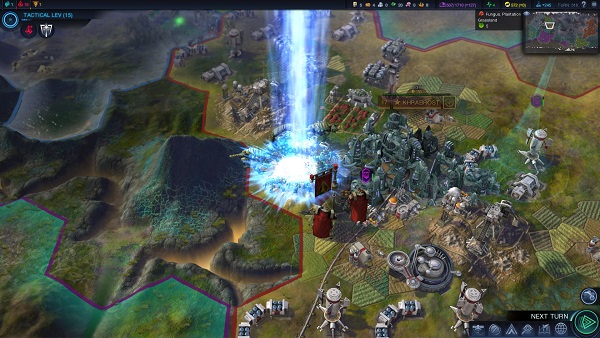
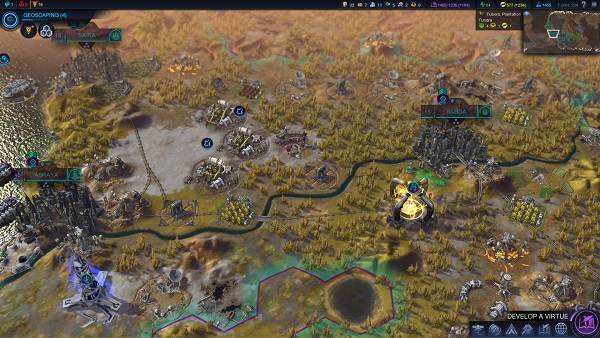
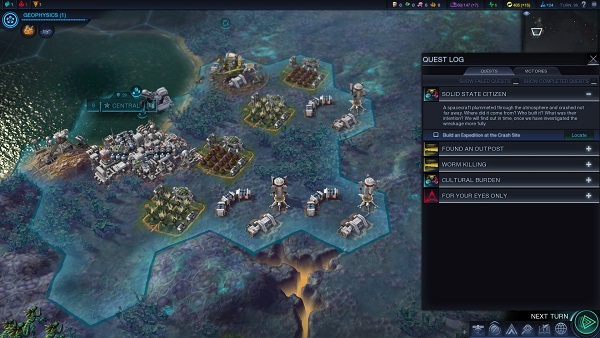
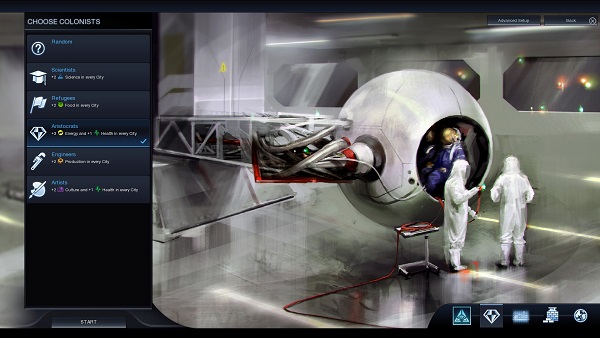
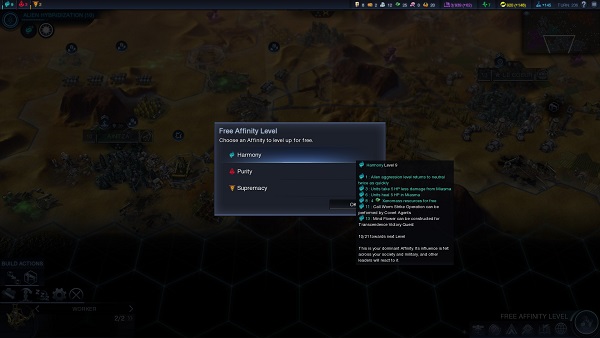
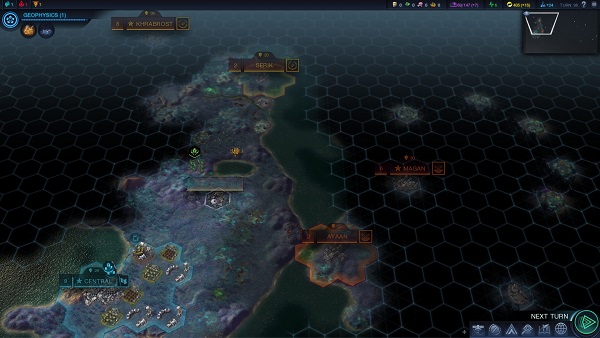
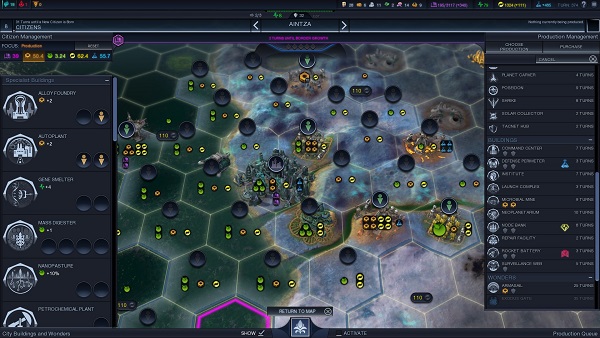
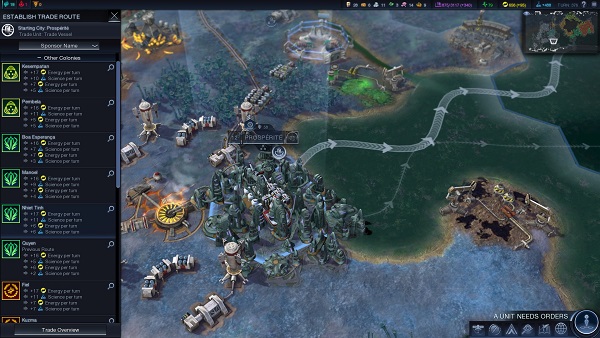
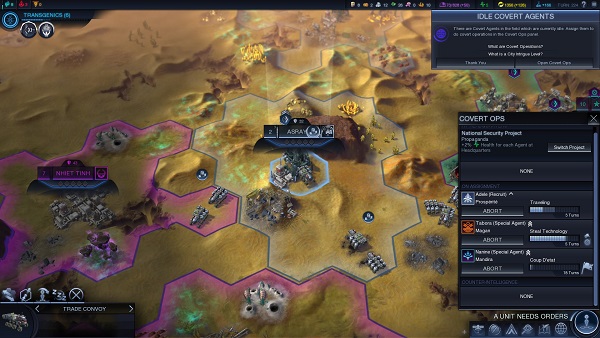
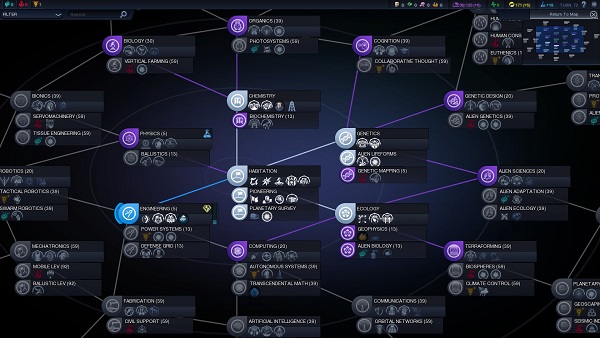
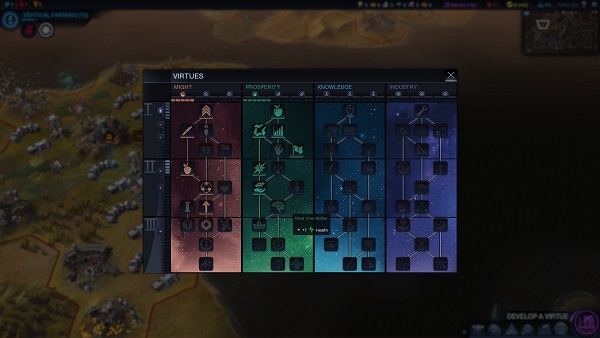
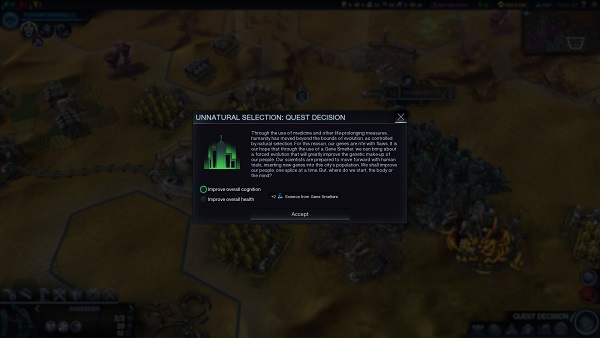
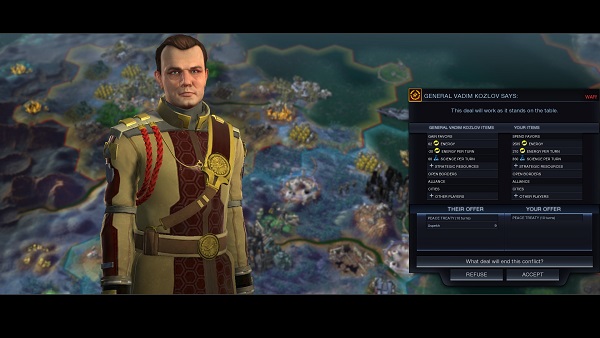
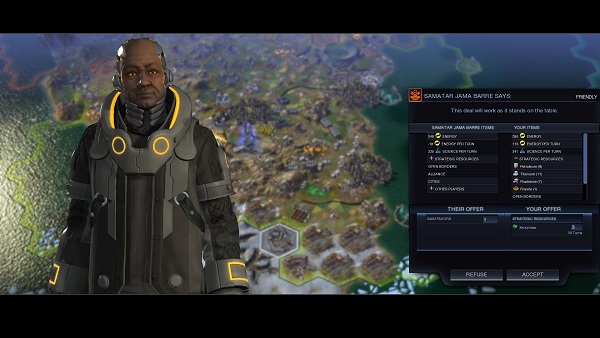
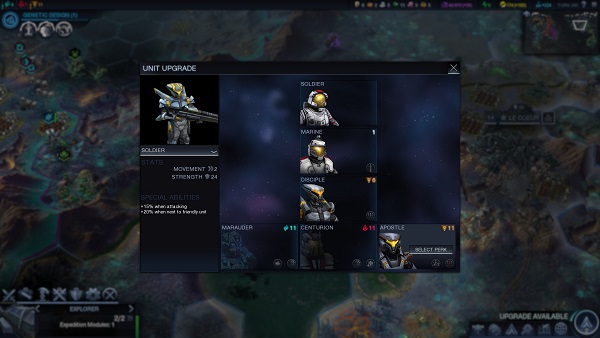
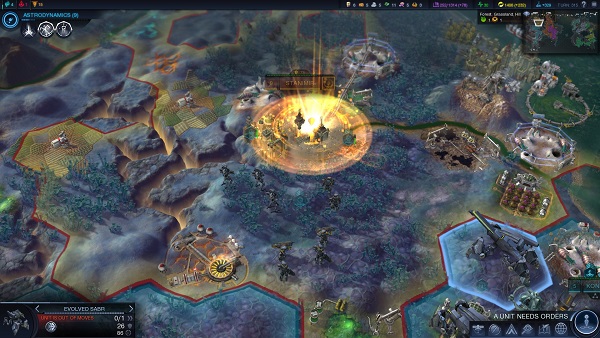
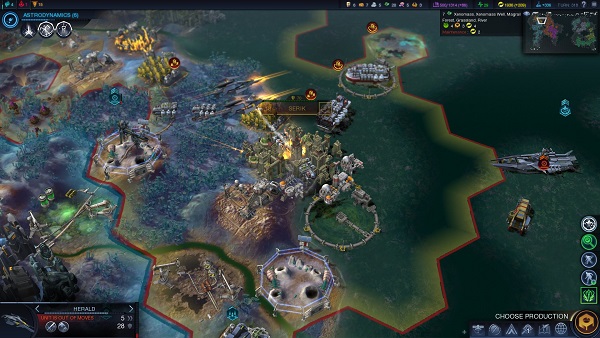
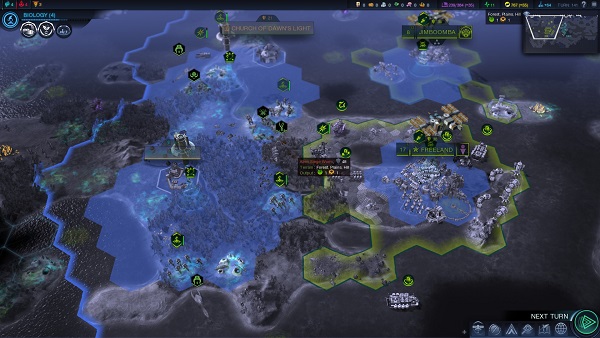
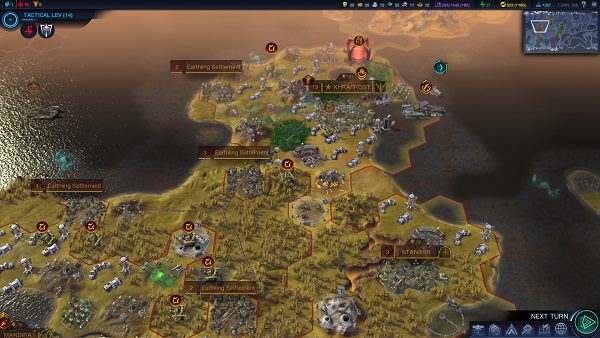
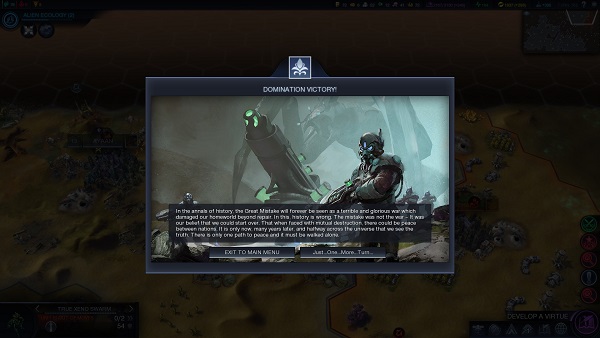

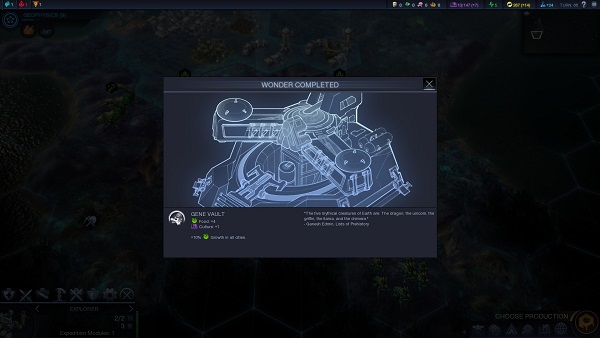
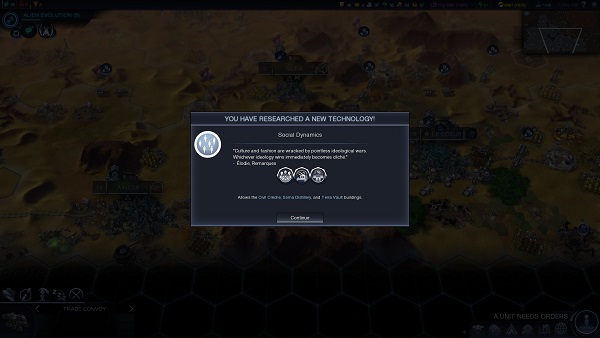
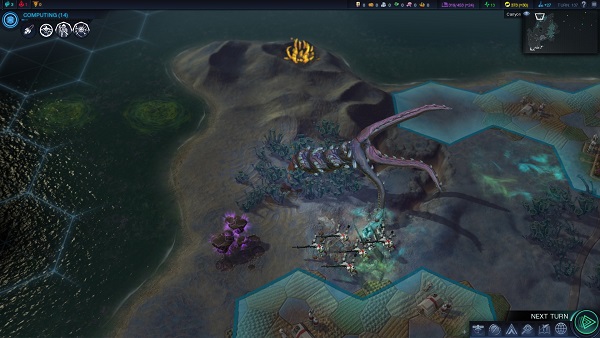

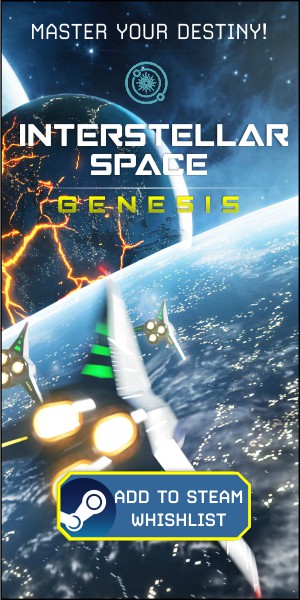





CBE is for me the greatest disappointment of this year.
The game is not bad as itself, but when you compare it to Civilization V it is just a reskin in my opinion.
I do agree with all the bad in the summarization of the score, but I can only agree with Visually good among the pros (but honestly it is just the Civilization V level).
There might be pretty much options in customization and during the game, but for six games I have been playing I realized there is always only one “best” way, that leads to the point where I have got those same units in every game, because that was the easiest way to overpower enemies and aliens.
And what bothers me the most is complete lack of the replay value. I’ve spent more than 600 hours in Civilization (according to STEAM, but some of my games were offline) and this is the game I’m going to play again.
If there won’t be Civ V, Alpha Centauri, Civ IV and Civ III, then purchasing CBE might be a good choice.
Now if you are not a 100% fanboy, just stay away and wait for at least 50% discount. IMHO this is only a mod (or add-on) for Civ V.
Just look at the STEAM users score. It is below 60% and falling down every day.
Overall, I’d agree that this game was “bad” outright and yes, one of the largest disappointments for 2014.
Let’s see:
– Lack of immersion, which is what made SMAC so unique
– The factions are not that important and rather bland
– Global health system seems to be dumbed down (contrast with say, the worker-talent-drone-specialist) system in SMAC
– The diplomacy system has also been simplified a great deal
– Unit selection appears to be bland
– AI does not appear to be that intelligent (same flaws as Civ V it seems and probably terrible at waging war too)
– Balance needs work … expected for an early release, but still it detracts from the overall experience
The affinity tree has replaced the social engineering system in SMAC – no comment though on which is better, but I would not be surprised if the social engineering trait was overall better.
@Edward, how is the terraforming in this game? You mentioned that it was the exact same as in Civ V? Can you elaborate on that? There doesn’t seem to be much that makes it unique compared to earth the way Planet in SMAC was.
From the perspective of a SMAC fan, it’s a pretty underwhelming release I’d have to agree. It doesn’t feel like anything other than a re-skin of Civ V, and judging from what this review is saying it seems to have very similar flaws.
I wonder if we are past the sort of “golden age” for Firaxis. They are just going to “play it safe” and abandon all innovation?
Anyways, thanks for the very extensive write-up.
I always saw the Social Policies (of Civ V) and Virtues (of BE) as the replacement for social engineering. Social engineering was interesting not just because it was good, it was practically a first.
What I mean is it shows up in SMAC a game made after Civ II. The closest (and frankly I believe it was inspired from social engineering) we got was the Civics in Civ IV. I loved the civics and to think they have their bases in a game that came out much before it. That is interesting.
Now I don’t hate the Virtue/Social Policy of the last Civs, I actually like them a lot. That said, I much preferred Social Engineering and Civics.
When I first heard about Social Policies and Culture in Civ V, I thought they were going to have a system like Civics but one that grew not just from tech but from your cultural output too, which sounded awesome and I wish that is what we got.
As for your question. There is none in the traditional sense. You only have tile improvements. The closest we get is that there a lot of techs that make these tile improvements crazy useful, and others that introduce unique high-tech tile improvements. However, you never get to change the tile types themselves (except for the cutting down of trees and clearing of marshes). You do get some city buildings that increase the yield of sub-optimal tiles.
There are satellites which boost the output of tiles, and two satellites that even add basic resources and strategic resources randomly. But that is it. Not sure why they couldn’t have any that shifted the terrain type.
Oh! There is the Terrascapes. They are expensive to maintain and turns any tile into a really good tile. However, many times the cost is not worth the boost and a natural improved title will be better. Also, it is static, you only have one Terrascape. Also, the tile itself is the improvement, so it is not like you can build an improvement on top of it. They seem to be only useful to turn junk tiles into something worthwhile in the mid and late game.
So basically it is just turning your tiles into super-mega-rainforests from Earth. So I wouldn’t call that terraforming either, but it is the closest we get.
IMHO the Virtues in BE are rather well made.
The issue is that SE/Civics are (IMHO) inherently superior because :
1.) They allow for much more dramatic changes you have to prepare towards
2.) They have negatives, which makes for more flavor
3.) Once you choose one, you’re not stuck in it for the rest of the game.
I feel you forgot one very important aspect where SMAC is much better than BE : warfare. On the contrary of what I often see in comments, the Multiple Units Per Tile system of SMAC is much deeper than the 1UPT in BE. This is because SMAC has probably more combat features than any other Civilization game : ranged artillery, collateral damage on the whole stack on unit death if not in base, terrain bonuses, no visibility in fungus, psi combat, morale (affected by drone riots and social engineering), 4 types of air units (though choppers being overpowered dumbs a lot of the game down), hard zones of control that can only be crossed by specific units like probe teams, probe teams that can subvert lone units in the field, 2 special abilities per unit, separate attack and defense values… and I’m probably forgetting some :
http://www.weplayciv.com/forums/showthread.php?48-Vel-s-SMAX-Guide&p=717&viewfull=1#post717
Good review! I was a little harsher on it. It’s a disappointment on many fronts. Firaxis dropped the ball.
Truth is, I don’t know that Firaxis had any clue what made Alpha Centauri or Civ IV special. It shows in each choice they make.
Ah well.
Also, I wouldn’t call it the “Firaxis curse” of needing more expansions to fully flesh it out. It’s more like a disregard or ignorance of what makes a complete 4X game, which is a shame considering that Brave New World is actually a good game and Alpha Centauri is a beautiful blueprint.
All they needed to do is look at one of their own products and a 15 YEAR OLD GAME and they may have made something special. Instead, it just ends up feeling like a well-funded space mod of the base game.
That’s not a curse. That’s poor design decisions.
Oh I agree, I call it the Firaxis Curse because it seems to be a staple of their products lately and (I may be wrong here) usually curses are named after the one that inflicts it. So in a way we are the ones that are cursed by Firaxis, or that the games gets cursed by their own development process (oddly, I see the game as a victim too).
I have a habit of sticking a bit of poetic flair, but I try to keep them for the conclusion only. Adam snaps me on the nose when they creep in elsewhere. :)
I agree that it feels they do not pay attention to their own lessons learned. (Devil Advocate On) In some regards it is natural a product that receives user feedback and gets incremental improvements over time will have a decent chance of being a really good product (Devil Advocate Off). That said, the amount of fumbling upon an initial release seems excessive.
I do expect some polish and fleshing out to be missing, and balance to be a little raw. However, I do expect past lessons to still be reflected and if they use an existing engine, I do expect more.
Hard to know where they dropped the ball, it seems they have great ideas on paper but have trouble executing it or bringing it to the front properly.
P.S. I read your review. I enjoyed it and it brought up some good points about some of the elements in BE.
The question is, are the expansions going to fix all of the issues though?
I would argue that for Civ V, they never truly did. The AI was never very good at warfare for example and the expansions did not address that issue at all.
My guess is that the expansions will fix some of the issues, maybe introduce their own problems in the process, and leave a so-so game at the end, which is arguably where Civ V is today.
I get that, I suspect they will only add techs, maybe vamp up the victory conditions, probably do some tweaks to diplomacy, with most improvements being management things (like trade routes, dear god…).
I guess they might add more difficult setting but I suspect it will be around giving the AI bonuses. I expect its skill will stay the same and they will never address the immersion issue.
Now, I do hope they prove me wrong. But I expect the expansion to only address the new mechanics and the most glaring (yet easy to fix) Civ V errors. To be fair that alone will significantly improve the game, but I expect some issues will persist till the end.
Speaking of Civ4, I don’t get all the love people have for that game? To me it wasn’t all that different from Civ3, and religion was way op’d. I like how religion is handled in BNW much better. I really enjoyed Civ5, because Sid was brave enough to sort of reinvent the series (in a mostly good way).
Have you tried Civ4 mods?
@JonhR: Sid did not design Civ5 (vanilla), Jon Shafer did. Six months after release he suddenly left Firaxis. Two years after he left Firaxis he wrote a very extensive and well argued post mortem about the development/design of Civ5 and why most of his decisions/choices were not as good or only half working or even not working.
He took a risk and it resulted in a mediocre/bad Civ5. This can happen. No risk no reward. But he had the balls to admit the game was not as good as he wanted/needed to be. And he learned from those decisions/mistakes.
What is mindboggling, is that Firaxis did not (completely ignored this) and continued to bolt more stuff ontop of this failed design. Resulting in the too many meaningless decisions game which is Civ5 today. And thus leads us to BE, which is being critized for EXACTLY this.
Civ3 was a good and proud Civ. A Civ that made players feel like they were forging an epic empire.
Civ4 is a good game with solid mechanics, but it still feels like fisher-price Civ to me. Still much better then 5 though.
I still think that getting rid of those silly monster unit stacks was the best thing the series ever did. I know several people have mentioned the monster carpets, but for my part I’ve never experienced that.
Anyway, all I know is that at the end of the day, Civ5 with all its expansions was the most fun I’ve had with the series since Civ2. “That’s all there is to say about that.”
And replacing them with monster carpets was the dumbest.
@JohnR: Hahaha, yeah we all have our favorite Civ and we all try to convince each other of that.
It’s funny you mention Civ2, as I am exactly the opposite from you regarding Civ5 (from Civ2 onward).
I love Civ V but I won’t touch this with a stick.
I’m 60 years old and have been an avid gamer for 20 years. But I won’t play a game that has poor visability, tiny icons, poor contrast on colors, etc.
Games have to be ‘seeable’. If they can’t get that right I don’t care how anything else is done.
I’m with you, Smoking Robot. I’m a lot older than 60, I have the same problems with tiny icons, color, etc. plus text so small I almost have to leave a nose print on the screen to read it. Even so, IMO there have been very, very few games equal to or better than SMAC. I don’t know what’ going on at Firaxis, but something has changed for the worst.
While this is true for the color palette, there are no easy ways to solve that for a developer for icon size, especially when more than a third (~36%) of your user base is using a resolution of 1366×768 or lower (on a 15.4 inches screen, that makes for huge icons in Civ:BE).
http://store.steampowered.com/hwsurvey
They would basically need to make 3 different GUI’s : one for 1366×768 (~”HD”), one for 1920×1080 (“full HD”), one for 3840×2160 (“4K”) (supposedly the future, but so far resolutions higher than 1920×1080 only represent about 3% of the user base).
Or make scalable GUI’s like in recent Blizzard games, which makes for its own set of challenges…
“I’m a lot older than 60, I have the same problems with tiny icons, color, etc. plus text so small I almost have to leave a nose print on the screen to read it. Even so, IMO there have been very, very few games equal to or better than SMAC.”
As an accredited Old Guy, I find SMAC eye-bleedingly difficult to play, much more so than Civ:BE. SMAC’s low-res graphics married to a pre-2000 UI is exceedingly distracting and completely mars the experience in my opinion.
I encourage anyone thinking of buying the game to try the demo before purchase. I agree that Civ:BE plays much more like a Civ5 expansion than a new game, and I too wish that Firaxis had been more innovative, but the new game is both easier on the eyes and more “comfortable” than it’s last-century predecessor.
Gamer consensus is pretty much that this is a weaksauce bland Civ V re-skin that is pre-positioning fans (bending them over) to rape their wallets for the needed expansions to flesh this out.
The sad thing is the legions of fans will fork out, perpetuating the cycle.
I wouldn’t play this if I got if for free, don’t want to reward Firaxis with my time.
And another thing… blueprints when you build a wonder? That sucks.
Civ IV had movies. V had nice artwork and music and a quote. This has blueprints?
This is no way to run an ‘A list’ game series.
My prediction: A few patches, maybe some DLC, but no expansions. No big fixes like ‘G&K’ and ‘BNW’. Nope, this puppy will be abandoned and they’ll go straight into Civ VI.
The best thing about this game for me? It made me start playing SMAC again and even after all these years, it’s still an incredible game experience.
One the things, a small thing mind you, that nonetheless bugs the heck out me is something the review mentioned early on: You have to manually explore the map, and even building satellites doesn’t reveal the map.
Are you kidding me? What a useless hold-over from Civ. You mean to tell me that colonists visiting a new world wouldn’t at the very least do a fly over the planet and map the basic landforms and continents before landing? I know it’s small – but it is SUCH an immersion breaker for me, and shows the level of thought/effort put into actually making the setting and context believable. The fact that building satellites doesn’t reveal the planet is ludacris.
– You can see some coast outlines when you start the game as one of the bonuses you can choose before starting the game.
– Making the first satellite you get reveal all the map would be gameplay-breaking, as you can get one pretty early (specifically, from a quest).
– Still, not having a high-end satellite or tech reveal the whole map is a shame.
I agree. They did not want the first Satellite to reveal the whole map (since you can find them in resource pods). But they could have attached the effect of revealing the whole map to a higher tier satellite or tech.
Heck, they could have had it as a National Wonder that you need to build that you unlock with a mid-tier tech. Nothing too extensive, but enough to require some effort. Or have Orbital Coverage reveal the unexplored tiles, that could have worked too.
A part of me feels the continental outline should have been a default thing, and have the bonus be something else. There is nothing wrong in shaking up how exploration works. It doesn’t always have to be the basic Civ 1 model.
Filling in the gaps and doing excavations on the map is exploration too and one that is more interesting and setting appropriate. The player will still need to explore to reveal a dig site and then actually do the dig.
The point I was trying to make is why have the map hidden at all? Why not DESIGN the game around having the whole map revealed/explored right from the start? It would’ve further differentiated the game from Civ V, made more thematic sense, and if they followed this approach could have opened up new gameplay ideas. Instead they remained stuck in past …. “you have to explore the maps because that’s what you’ve always had to do!”
Heck, even SMAC had a game option to start with the whole planet revealed/surveyed (an option I always used). Is such an option in BE?
Loved Civ4,,enjoy Civ5 yet my play so far has been very disappointing in CivBE. From the OP’d yet confusing Trade routes, an underwhelming quest system, the lifeless diplomacy, the terrain that is hard to see, to the useless and annoying “Favor” system. It’s now at the point that every two turns I’m getting bombarded with trade requests for favors. Talk about irritating!!
While I know it’s not case, it does seem as if all they cared about was unit animations. It’s hard to believe beta testers never mentioned the word “boring” to them. I would give it in it’s current state a 4 out of 10 rating.
I had to stop reading this about halfway through it. There were just too many instances of subject/verb disagreement. It is painful to read.
Is anyone editing or proofreading these articles?
That said, I’m saving my money on BE until an expansion or 2 are released.
Yeah, I hate to be a critic here, too, but I was really having a hard time, too.
I think English is not his native language. At least, I hope not.
I speak 4 languages and read/write 3 languages from 3 different language groups. I also spoke 3 of them (the 3 I can write now) by the time I hit elementary school, so I do not have a native language in the traditional sense.
My, that’s rich. ;)
Edward started his reply wrong. It should have started with:
“Listen, bitches. I speak…”
Kidding :)
I found his style very clear and easy to read. But then I couldn’t care less about grammatical perfection.
Glad I resisted the very strong temptation to pre-order this one. In any case though I’ve learned the past few years never to spend money on a game before it is released.
As far as this review is concerned, I found it informative if a bit overlong as is Space Sector’s wont, but it seems at times the reviewer was bending over backwards to say good things about CBE. On a related note, interesting how on the whole the gaming press has been much kinder to CBE than the players. Funny how that works???
Anyway, that’s three of my heretofore sacred cow developers that have gone way down in my esteem this year; Triumph for Age of Wonders 3, Sid Meier for CBE, and Bethesda/Zenimax for Elder Scrolls Online.
Do you think AOW3 might be worthwhile after a few more expansions?
I’m hoping that’s the case….
What was wrong with AOW 3? I only played it a bit (friend’s copy) but I plan on picking it up eventually.
Smoking Robot, Alien – I don’t know, maybe I’m looking back at the older AoW games with rose-colored glasses, but all I know is that I enjoyed them greatly, but was not particularly thrilled with AoW3. There were a couple of small to moderate things I didn’t like about AoW3, like the tiny number of factions compared to the older games and the largely meaningless hero upgrades. However, if there was one big thing that really bothered me, it was that I found the AoW3 campaign incredibly tedious. By contrast, the AoW2 campaign imo was the best campaign I’ve ever seen in a turn-based game. I agree though Smoking…..I also hope that AoW3 may eventually shine after another expansion or two.
Ah, I never have played a campaign in AOW3 I hadn’t noticed that. I’ve only played sandbox. You’re right about the races. It was disappointing that there were so few. I really wish they’d had undead.
Yeah, I hate to plug my site here, but it does seem like the media has been far too easy on this game.
I was not. You can read my review through my name link.
I enjoyed reading your review DD. You seem to echo many of the issues that people have been griping about in the forums and at metacritic. Yes, this was a serious missed opportunity for Sid and Firaxis.
I had to laugh at your closing comment. It seems to me that Dan DiCicco made a similar comment about the inconsistent AI of the more recent Civs when Space Sector interviewed him about two years ago.
Anyway, how I would loved to have seen BE become the spiritual successor to Alpha Centauri. Those great philosophy quotes against the backdrop of moody music and atmospherics (to say nothing of the great gameplay) makes me wax nostalgically. Come to think of it, I’m hard pressed to think of a 4X game that has more personality than AC. But I digress.
It actually works both ways.
Find a fan loved game, and I will bet you my blood, bone, and soul that you will have players wondering why a site did not give it a 10. Or getting pissed that the reviewer criticised feature A or B and that the game, “was never meant to be played by someone like them.”
If you don’t believe me, look up Dark Souls and GTA V. Any reviewer that found any flaw in those game got criticised for being too critical. I admit there might be cases of the game getting some bizarre criticism that doesn’t seem relevant, but as a whole the press got criticised for being too critical.
I am serious, people were treating a 9 as a low score! I wish I was making this up. Funny how when it happens the other way around no one remembers it.
The reason is simple, barring those that might be crooked or have a stupid bias, or following a political agenda instead of reviewing games on their own merit, reviewers will usually try to see both the good and the bad, and then see how the balance tips. They will also try to keep expectations out of the final score. They will talk about it, but will usually score the game on its own value.
This is where you can insert the old debate: can something be scored in a vacuum since that vacuum doesn’t exist? What makes it in as a metric and what doesn’t? No one will ever agree on this.
This is why a lot of people do support the mechanism that reviews should do away with scores, since the written part is far more informative and is likely to contain more perspective on the game itself. Also, why the comments sections and reader/player reviews have also become popular. More data for the consumer.
Yeah, or how 70-80% is considered “average”, and the reviewers that dare to give the (mathematically average) 50% to a game they find “average” get a lot of flak for that…
I actually read an interesting article about that once. If I could find the link for it, I will post it but to no avail my Google-Fu fails me.
He mentioned the nature of game review scores and felt it stems from the school grade system. Where a 5/10 is the bare minimum of a pass. Some places even use a 6/10. At many Canadian Universities a 0.5 is a pass for credits only but not for a requirement purpose, you need a 0.6 to be able to proceed further down the course line.
This is probably why the perception of many readers and reviewers of 7 being an average score. Since anything less than 5 is a flat failure. Being in school for 10-12+ years under this paradigm really enforces this perception onto you heavily.
So in many regards game scores (books and movies too) do not follow mathematical distribution but grading distribution. Even Space Sector, check our score page, you will notice anything less than a 5 is bad. A fail of sorts.
The two problem that arises from this model according to the author is: A) What is a pass in gaming? When does a game pass or fail? Usually schools have a detailed list of what the minimum is for a pass. B) The bell curve maximum lands at the 7 mark (on a 10 scale). So you only have 3 points to grade quality, and 7 points (or 6 points if you have no zero) to grade ‘crapiness’ with a full 4-5 points to grade failure alone.
You have more points to grade failure than you do for quality, with a small window for mediocre. To make things even more bizarre, if you do not have a score 0 (like us, 1 is our lowest score), then the mathematical average is 5.5 (ah die roll distributions, we meet again).
Either case, the mathematical average ends up meaning little since most sites use the ‘school’ grading distribution. Despite the flaws I listed earlier the system is intuitive to many reviewers and readers because of schooling. The score feels like a grade of sort.
Frankly, no one should be happy with a C. Especially Firaxis.
You probably can get from my writing that I’m not a fan of numerical scores (like TotalBiscuit). That said, I am not going to nag Adam about it either. He runs the site, if he wants me to score games I will and I will use the scale he provides me with a smile on my face.
Either case, that is why I think we do lengthy reviews and we hope our readers read the whole thing. It is far more useful and informative than the score is alone. I like to think of our score and the pro/con box as a cheat sheet.
On a related note (to Edward’s post), fanboyism seems to be rampant these days. For example, although I want to try Endless Legend, I’m troubled by how on metacritic you see a lot of negative votes on anyone not giving the game an 8-10 . My gut feeling is that fanboys and shills are responsible for that.
It seems that back in the day if you liked a show or book or whatever, you might mention it to your friends. Now, however, people post lengthy blogs and name their pets, mmo avatars, or even children after their favorites. Another case of the lunatics taking over the asylum. lol
BTW, the worst fanboy community by far has to be the Star Citizen bunch. It’s like instant character assassination in the forums on anyone being even mildly critical of the game or his nibs Chris Roberts.
Everyone who played other Civ games, especially V, are disappointed by BE for good/legit reasons. People who started off the franchise with BE largely enjoyed the game because it IS a very polished and enjoyable Civ game.
How should a reviewer approach games like this? Review it on its own merit or factor the predecessor-baggage that inevitably comes with every franchise but not necessarily applicable to a lot of newcomers?
Good question and I know where it comes from. The issues with Civ BE can very well be applied to Vanilla Civ V. I only played about 16 hours of Civ V Vanilla before I took out the disc and flung it against a wall. I had serious anger management issues back then.
The divide is not just at the new versus veteran level, think of Civ V (not the release, but the current version), you still have a good portion of fans that still hate it after BNW because it ruined all that was great in IV. As a franchise gets older you sort of get a divide there as well.
I suspect it comes from the fact person A probably likes a game for feature A but not feature B. Person B is the other way around. Naturally the game will choose to revamp one of the systems, which ever they choose, it will piss someone off.
I think that is why a lot of reviewers try to have a ‘blind eye’ when they review. Imagine I wrote this review from the perspective of a SMAC fan. The score will be way lower. Imagine I reviewed in perfect comparison to Civ V BNW, the score will also be lower.
Though I would have gotten high 5’s from people who share those perspectives, I would have been criticised by others who don’t care for Civ V (but are still okay with BE, which honestly is an odd bunch), or in the case of SMAC those that either never played it or liked SMAC for a different reason than I did.
So which bias does the reviewer use? No matter which they choose someone will get pissed or strongly disagree. Even when some bias are safer and probably more appropriate (like in the case of BE, that is the Civ V BNW one), you’ll still get complaints.
Also, nothing is served if you go with the bias that ‘the largest subset would agree with’. It is safe, and gets you the most praise, but what does it serve? Did the reviewer bring in their own perspective or did any critical analysis, or are they just saying what the largest demographic wants to hear? There is a word for that, ‘hug box’. Even if you wanted to, how do you even know which is the ‘prevalent accepted bias’. Everyone thinks theirs tends to be the one.
This leads to why many reviewers will probably try to have a blind eye. Especially for the final score. When it comes to the written part, the biases will be able to shine a bit but they will only exist within the written review itself and usually in moderation.
I wish to add, this is probably why you are getting a split on how reviews should be handled.
One school believes that you need to try to be objective. However, since a review will be highly subjective by nature, dependent on the player’s experiences and bias, and a combination of expectations or lack thereof the endeavour may feel futile by many. It feels like you’ll just piss everyone off. Also, second guessing yourself because it is hard to know if you achieved a ‘as objective as possible’ review.
The second school is reject objectivity and accept that the subjective is good, that having a bias is great and not something you need to curtail. It is easier, you will have at least one group that will adore you for it, and you can justify any bias as legit as long as you have a base that supports it. However, you now see the problem with this, any bias that has support. This will also include biases that have nothing to do with gaming.
So you either end up with a review that seems detached, and will find merit in a fan disappointment and flaws in a fan favourite. Or end up with one that will hopefully agree with your expectations (in a sea of many that seem to be flat out wrong about theirs), but then get caught flat-footed that suddenly that same reviewer is shoving an agenda down your throat.
If you’re lucky, that last part never happens… but usually it is more like you agreed with them till one that is not expected is brought up. Which can be jarring.
Well-said Edward, I believe I read that article you mentioned about the flawed and simple-minded nature of numeric scores for something as subjective as entertainment in general and games in particular. If I’m not mistaken, his solution was that reviewers should dispense with numeric scores and just tell us what they liked and didn’t like about the games.
Yeah, the idea is that the reader will be more inclined to read the review. You can still have a shot-box at the end but even that will be far more informative.
Those of the first school can still be critical and aim for the difficult and unattainable ‘objective’ state that they strive for all the same (the score never really helped with that endeavour anyways). Also, any bias that does exist will be apparent to the reader.
As for those of the second school, will probably have an easier time too, and their bias will also be much easier for the reader to spot. Letting the reader shop around to find a compatible reviewer.
The end result is the reviewer will be able to convey the information he wants, while the reader will be able to shop around and find one that aligns with their preferences and even be able to read counter-points from other perspectives if they care for that as well.
If you think about it, some of the better and more respected reviewers already go to great lengths and always encourage you read the whole thing.
If you haven’t played AoW3 in a while, the base game has been patched significantly a few times and the first expansion added a considerable amount to the content and overall experience.
If your primary concern is the lack of races, consider that in many ways AoW3 has more races, as each class and race combo has distinct unique elements to it. Mainly, your race impacts many class produced units making them different from the other races equivalent. Its a subtle thing but has big gameplay implications.
I’ve never been a huge fan of campaigns, tending to prefer random maps vs. the AI. The game has become better in this regard as the patches have improved the AI, economy, balance, etc. in many ways.
Sorry for the plug for AoW3, but it’s worth another look now that it has been updated quite a bit.
+1 actually to what Mezmorki said. AOW3 is quite solid now for me – and AI does not give me trouble as such, but I had a few surprises so far. AI was my biggest concern before buying AOW3. Now I do not regret buying it at all – and spent already huge chunks of my spare time on it.
As for CBE, I did not buy it. There are so many good games out there right now, why should I spend money on a flop? Even if it is grandmaster’s flop.
It is funny however how huge companies like Firaxis with a lot of resources and pointy-haired artists can’t make a game which people used to make on a back of a napkin 15 years ago.
Sack’em all I say, sack’em all.
Cool, I really wanted to like AoW3, considering how much I loved the earlier games in the series. Maybe it is time to give it another try.
I still maintain that Aow2 had the best story-driven campaign I’ve ever seen in a turn-based game. I’m hard pressed to think of another turn-based game that even comes close in that regards. I seem to recall Brad Wardell at Stardock very pompously proclaim that the reason they didn’t do a campaign in SINS was because 4X games don’t lend themselves well to campaigns, but imo AoW2 proved him wrong.
BTW, it is well that that AoW3 is offered at GOG, as I’ve made a morale decision never to buy another game that requires a Steam/Valve account. Those people at Valve are criminals. They make EA, Perfect World and NC Soft seem like saints by comparison. ;)
I preordered the game and played about an hour and just can’t bring myself to get back into it. It just feels generic and I really dislike the new research system.
I’ve played it to death last few weeks, I’m soon done, having explored almost everything in the game. It’s not a bad game but not really worth it weight either; far too much is missing compared to CiV V and while it’s expected expansions are supposed to bring something “new” (that was already introduced in the previous games), I think they embrace that strategy way too much. What’s missing now is day 1 DLC like Bioware did with ME3 – and they’d be on the same level as EA/Ubisoft. There’s no justification for the game to lack this many features & polish.
Civ:BE suffers from the “split faction affinity syndrome” : the real factions are the 3 affinities (but even they aren’t represented and differentiated that well in the game besides graphics… and maybe special units).
Steam review’s positive/negative ratio is pretty brutal. You know things are bad when people start talking how good Civ V was by comparison. =)
Civ/Firaxis is like COD now – able to sell loads simply by the virtual of its brand but at the same time, too scared to meddle with the formula. Eventually, it’ll release a Ghost but until then, upper management will NOT rock the boat that’s still bringing in the $$. I feel bad for those people who ordered GalCiv 3 because that game also looks way too similar to its predecessor.
Every decent sized company should have an incubator department where crazy stuff can still be experimented with without having to worry a bad sale laying off half of the workforce. Can you imagine Google now if it doesn’t have the crazy stuff its employees came up in their spare time?
I think we are experiencing what the movie industry did prior to the turn of the century (and still is aching with it now). If you recall everything was a teen comedy, the ‘chick flick’, and the action hero movie. You can even see which of the 3 demographic was getting catered to with each.
We keep hearing the video game industry has become bigger than Hollywood. Perhaps it has and now it has the same problems too.
These games all get huge budgets and a lot of money is at stake. Shareholders do not like risk and want ‘assured revenue’ for their investments. Decisions are made to factor the bottom line above anything else.
The end result, they want to play it safe till it explodes, then they innovate just so far to get some of the prestige (sales and rep) back and then go back to playing it safe. If they fail at that junction, they die and are replaced by another, who will play it safe once they take the spot.
I mean, Square Enix acted startled when they did a more traditional JRPG for the 3DS and it sold well. They were surprised that there was market for it (which then probably explains the weird direction the FF series has been going through). Less we speak about what happened to Resident Evil and the survival horror genre the better.
In the end it feels investors will only invest into projects they feel will succeed, which is usually based on what worked before. Hence why the studios play it safe, to make the project attractive to investors.
I have friends in the scene, and they literally tell me stories where potential investors literally ask them how their project compares to ‘insert popular title here’. Look at the surge of RTS’s after StarCraft 2 or look at the surge of MOBA’s after LoL.
Even the more niche genres, after Civ V continued good sales with its expansions how many Civ V like games we got and we also got a surge of 4X games in general. Not sure what kicked up the storm for the space 4X genre, but it is now here. After Crusader Kings II we got a few grand strategy games from other companies popping up. Then there are the Minecraft clones.
A bit tangent to your main point, but had I had to comment on your mention of ‘action hero’ movies. I see tropes from those kinds of movies all over games these days. The testosterone tough fighter pilot in the Star Citizen video, the cheesy military clichés in StarCraft 2 and XCOM:EW, to say nothing of the cringe-worthy modern military style dialogues in Guild Wars 2. Gosh, I begin to think that publishers think only teenagers play their games.
The 1 UPT rule was supposed to solve the “stack of doom” problem. Instead – in Civ V anyway – they were replaced by the even more annoying “carpet of doom” where you have to tediously shuffle your entire continent-sized carpet of death, one unit at a time, hex by tedious hex every fricking turn.
To add insult to injury, the AI seemed to have absolutely no idea how to organize, move and position these carpets efficiently.
Does Civ Beyond Earth suffer from the same problem? If so I think I’ll give it a miss until someone at Firaxis comes up with a less frustrating and brain-dead game mechanic.
Both Good and Bad:
The Good:
There seem to be smaller armies now. The game seems to have a faster pace, faster to build units, faster to build buildings, things kill and get killed faster. Even undefended cities (as in without City Defense Buildings) are pushovers. I would say even a defended city will need to be careful.
The AI seems to keep its ranged units behind its melee units finally.
Only in long games on very aquatic maps will you see the 7 Hex Naval Squadron. Since there is only 2 naval units, I am not sure why they still do that.
The AI seems to fight in smaller squads, melee and range unit groups that move and try to snipe out a city. They tend to be small compared to a carpet of doom.
The Bad:
The AI doesn’t seem to know how to fight, even with all the good it is not hard for the player to take on 2 to 1 odds in defense. The player will need an edge on the offensive, but with smart play (which is not hard to pull off) you will be able to bleed the AI (when it attacks you) and then parade onto their lands.
The player will tend to out produce, out tech, or out affinity (which heavily boosts your military) the AI. Even at the highest difficulty a player will not have too much trouble (the highest diff is closer to Emperor but if the AI has a bad start it feels more like King).
The AI seems to have a lot of trouble dealing with aliens, but considering how easy they are for the player… this is baffling. An AI that is cornered by a bunch of nests will lag behind even on Apollo.
Lastly, if a group of nests is ignored for the whole game on a larger map it will create a carpet if they are close enough to each other. Fortunately, you can ignore them because they won’t really move out of that area. This is very true for aquatic aliens, where 6 Krakens will just hang out in a spot.
Overall:
I feel the player will always be able to have an edge and the AI seems to have trouble to keep up. If you can beat Emperor level in Civ V, BE will offer little challenge, even King level players will find themselves playing at the highest difficulty levels soon enough.
Except for the free-ranging aliens, there seems to be less units at play so the carpet is much smaller (for the factions only, the aliens can get… pretty clustered). Also, the faster turn-over rate means things move along faster. Though the AI avoids the stupid mistake of charging in with ranged units, it is still a pushover in wars.
At least it keeps the artillery behind the soldiers now…
Keeping the unit numbers down will definitely help mitigate the problem although it doesn’t do much to promote an epic feeling when you only have a few units in an army.
Not surprised about the AI shortcomings. Seems like every strategy game released nowadays has a sub-par AI.
Great review btw, I love the detailed, comprehensive reviews that you and the other Space Sector authors do, really makes it easy to decide whether to spend your money. Thanks for all the hard work, it is much appreciated.
…”the “stack of doom” problem” that didn’t need to be solved by a new mechanic, considering that it had already been solved in 1999 in Alpha Centauri.
Yep, totally agree. The whole 1UPT idea is 2 steps backward as far as I’m concerned. If they wanted to inject a tactical feel then they should have zoomed the battle to a small scale tactical map like Age of Wonders does rather than stay on the strategic map with 1UPT and have archers firing over mountain ranges and armies that cover half a continent.
I did a small mental volta. I didn’t compared Beyond Earth to Alpha Centauri. I compared it to recent try, Pandora. And suddenly it was totally awesome.
But still, trade…
Trade…
Yes, I feel the game rewards rapid expansion over building up. I guess some players will love that and perhaps this is what they were aiming for. However, I feel they might have toned it too much in favour of going wide and fast.
Also, we need better management tools. If you are going to make us have 15+ trade routes if not more with huge lists of 50+ cities, then gives us better tools to sort the list and even have a means to quickly repeat a route (and see its yield at a glance) without the need to scroll through a list of DOOM!
By end-game on a larger map, you can easily have 3 trade routes popping up a turn, each needing to be sorted through a long list every single time. You also can get this nightmare easily on smaller maps too. Now imagine trying to go for a Purity Victory at the same time…
Funny you should mention Pandora. Loved that game at first. Haven’t played it in a while, and I should probably revisit it. However, one thing that annoyed me about Pandora was how the more I played it, the more it seemed like extreme military aggression was the only viable strategy.
BE has that problem to a lesser extent. If you are not number 1 in production and science you will not start your Victory Countdown before your opponent. Assuming you do not want to loose, you will only have one option, roll over their lands and blow up their wonder.
Fortunately if you can get your wonder out of the door before anyone else you can play a peaceful game.
The problem too much can trip up. Promised Land is minimum 20 turns, Emancipation is minimum 10 (and does require a lot of production to pull that off), Contact is 30 flat, and Transcendence is 30-bonus (all standard speeds).
So getting Contact up and then someone pops down a 23 turn Transcendence 5 turns in means you will lose by 2 turns no matter what. You can’t speed up yours any way what so ever. Your only option is to take out their Mind Flower if you want to win.
This sort of mega race to the finish line is triggered when you start researching the final tier of tech, and since you will always pick these up before any other final tier techs, means you won’t get to research many of the other final tier techs. Heck, you will only get a small fraction of them. Maybe 3-5; however, remember this also includes the leaf techs.
You think you mean lose, not loose, right? :)
I wrote lose… what are you talking about Willis?
(whistles innocently) ;)
You are absolutely right. I at least wanted to love Pandora, considering that on a first glance it have everything a 4X strategy needs to have to be loved. Unfortunately, all there is in that game is warfare, rest of the content is totally overshadowed by fighting. Science, expansion, just everything serves the need to build largest army ever. And not even to steamroll the enemy by impunity, just to survive, as enemy strategy in every last game looked like that: one faction (usually that religious wackos, but everyone does it, even ecos) furiously attack and conquer all others.
In the grim darkness of distant future there is only war…
But this is not WH40K, and it should not be, civ-type games strongest point is freedom and many possibilities of playing, which Pandora don’t have in the slightest. And that is why Beyond Earth is much better.
Btw. Beyond Earth actually have as much flavor and background as Alpha Centauri, but for some incredibly weird reason players don’t ever seen that, unless they read encyclopedia.
Background, maybe; flavor, certainly not : it takes more than descriptions hidden in the in-game encyclopedia!
Also, I wonder if the world is nearly as “coherent” as in SMAC, or if it suffers from the similar issue to Endless Space where it would seem that tech descriptions were written separately then almost randomly assigned to the tech tree.
I gave up on the modern civ series and went back to civ4, they’ve yet to entice me back with the later offerings and this latest installment, I’m sad to say is no surprise at all.
I’m in the same boat, found Civ V very underwhelming, even with expansions. Hated the 1UPT, horrible AI that cant use 1UPT and overall dumbed-down feel. I still play IV when I want my Civ fix.
Wanted to add my opinion on research. I hate the current strategy games decision to present research as a spreadsheet to pick and choose from !!! It makes zero sense. Researching is about taking current knowledge ,exploring the unknown and then discovery. Then taking that discovery and exploring new possibilities.
Their supermarket spreadsheet research is like you already can read about and know what an Atomic Bomb does before you even discovered fire ..,it’s moronic.
Classic games let you decide an area to research and it was both logical and fun.
Gameplay >> Realism
Civ:BE’s tech web is awesome because of all the potential choices you can make.
And for people like you, implementing on top of that a “Blind Research” system like in Alpha Centauri shouldn’t be too hard.
Firaxis actually missed a big opportunity here : a blind research system for new (either to 4X or science fiction) players would have helped a lot with the “lost in technobabble” feeling.
LOL,,I’m not lost in it. Been playing strategy games over 30 years. I just don’t like it. A priority system to me is both fun and more logical. :)
Just to be clear, I don’t mean that your way of playing is somehow wrong, it’s just that it’s probably in the minority (though I could be mistaken), and that it can be easily arranged without removing the other way of playing.
Also I didn’t mean that you were a new player, just that this kind of system is a lot more forgiving and easy to get into for new players.
I don’t like it. I want a game from them where I can explore, colonize and conquer planets and galaxies.
BE looks like an advanced mod to CiV V.
TotalBiscuit was somewhat diplomatic on this game (pay attention to his tone near the end), while Tom Chick bashed it (the only one that I’m aware of atm … that dares to be blunt about it). If you take the middle-ground between these two, I’d say it falls around the mediocre level.
7.6 is overtly generous.
Yeah but Tom Chick’s job is to bash things and get clicks from Metacritic where he’s often the single “red” mark on the “critic” side.
I am a huge fan Civ games. This one is just simply boring from the start.
It’s kind of rip off Civ V done badly.
My major complains are:
* Not even close to Alpha Centauri
* Colors that makes the game just annoying
* Tech tree so confusing – don’t really feel the tech development
* military units cannot be customized as in Alpha Centauri
In the end.. If I knew how plain and boring they make the game I would NEVER bought it!